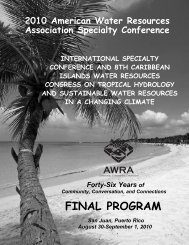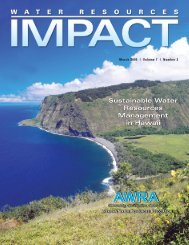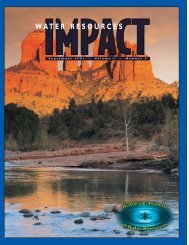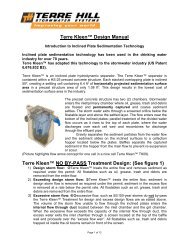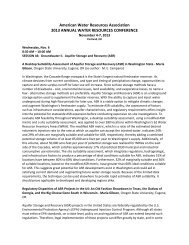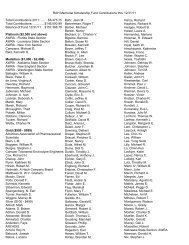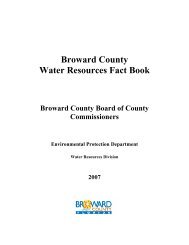N ovember 2 0 0 0 ⢠V olume 2 ⢠N umber 6 - American Water ...
N ovember 2 0 0 0 ⢠V olume 2 ⢠N umber 6 - American Water ...
N ovember 2 0 0 0 ⢠V olume 2 ⢠N umber 6 - American Water ...
Create successful ePaper yourself
Turn your PDF publications into a flip-book with our unique Google optimized e-Paper software.
Counterpoint<br />
AGRICULTURE AND WATER MARKETS IN THE NEW MILLENNIUM<br />
Clay J. Landry<br />
I want to thank Samson and Bacchus for pointing to a<br />
few of the differences between eastern and western water<br />
law. They suggest incorrectly, however, that these differences<br />
mean that water markets are unworkable in the<br />
eastern U.S. These differences simply mean that eastern<br />
water markets will take on a different form than their<br />
western counterparts.<br />
<strong>Water</strong> markets may not be as unworkable as Samson<br />
and Bacchus suggest. In fact, there is a growing body of<br />
research examining ways to make water markets function<br />
for eastern states.<br />
Johns and Yingling (2000) provide one of the most<br />
concise articles to date. They describe how markets could<br />
address Florida's growing water scarcity and environmental<br />
problems using the state's existing water permit<br />
system. Essentially, they contend that water would move<br />
to its highest valued and most efficient uses by simply allowing<br />
permit holders to trade their allocations. They also<br />
accurately point out that through trading “a water price<br />
will evolve” and that the price will encourage conservation<br />
among users.<br />
Samson and Bacchus suggest a more bureaucratic<br />
approach. They assert that conservation should be encouraged<br />
by holding permit extensions ransom until efficiency<br />
measures are undertaken. This approach will likely<br />
result in ineffectual measures that simply attempt to<br />
appease regulators. Prices are far more powerful in<br />
achieving conservation. In addition, markets also ensure<br />
greater efficiency gains for water conservation. Trading<br />
encourages conservation from those water users that can<br />
implement it the cheapest and prevents other water users<br />
from undertaking expensive conservation measures to<br />
save small amounts of water.<br />
Johns and Yingling's market proposal also addresses<br />
environmental protection. Florida currently applies a<br />
three-part test when issuing new water permits. One part<br />
of that test is that the water use must be “consistent with<br />
the public interest, which includes environmental protection.”<br />
That same condition would apply to water transfers.<br />
In essence, regulators would have a chance to review<br />
and condition market exchanges for environmental<br />
needs. Johns and Yingling present a way forward for<br />
water markets in Florida. Yet that may not be enough.<br />
The short-term nature and bureaucratic uncertainty of<br />
water permits may stifle longer-term market development.<br />
Two economists at Environmental Defense (formerly<br />
the Environmental Defense Fund), Vaughn and Emerson<br />
(1996), offer an alternative water market approach for<br />
Texas’ Edwards Aquifer, an area facing problems similar<br />
to those in Florida. In recent years, overpumping of the<br />
aquifer has dropped water levels, threatening to dry up<br />
several large springs that provide critical habitat to several<br />
endangered plants and animals. To address these<br />
problems, Vaughan and Emerson suggest a market with<br />
water rights that are based on a proportion of the<br />
aquifer's annual safe yield. This ensures that the aquifer<br />
maintains a minimum level. Each year the yield would be<br />
announced to determine the amount of water each right<br />
holder is allowed to extract. <strong>Water</strong> users are able to make<br />
up any shortfalls by purchasing rights from other users.<br />
This market design centers on environmental protection<br />
and Vaughn and Emerson feel they've developed a workable<br />
approach with proportional water rights.<br />
Florida is just one of many eastern states that will be<br />
forced to deal with growing water scarcity in the next few<br />
years. One option is to proceed with command-and-control<br />
regulations that specify how much each water user<br />
gets. The problem with this approach is that politics determine<br />
who has access to this vital resource. <strong>Water</strong> and<br />
politics simply don't mix.<br />
Samson and Bacchus sell markets short with their<br />
concerns. As demonstrated by Johns and Yingling<br />
(2000), Vaughn and Emerson (1996), and others, markets<br />
offer flexibility for addressing numerous problems.<br />
But one element fundamental to all market proposals is<br />
that price determines allocation. Samson and Bacchus<br />
see this as a problem; I don't. I see markets as offering<br />
the best hope among all other options for efficiently and<br />
equitably allocating this precious resource to its most<br />
highly valued uses. Any other solution ultimately results<br />
in a political race to the pumphouse. And you don’t have<br />
to look very far in Florida (or in most states for that matter)<br />
to see the damage of mixing water and politics. If<br />
markets are to work, Florida and other eastern states<br />
must move away from bureaucratically controlled allocation<br />
permits and toward a system of well-defined and<br />
tradable water rights.<br />
LITERATURE CITED<br />
Johns, Grace and Jay Yingling, 2000. <strong>Water</strong> Allocation Under<br />
Scarcity. Florida <strong>Water</strong> Resources Journal (June):28-31.<br />
Vaughn, Benjamin and Peter Emerson, 1996. Protecting the<br />
Edwards Aquifer: An Efficient Alternative. In: <strong>Water</strong> Marketing:<br />
The Next Generation, Terry L. Anderson and Peter J. Hill<br />
(Editors). Rowman and Littlefield Publishers, Lanham, Maryland,<br />
pp. 167-189.<br />
AUTHOR LINK<br />
E-MAIL<br />
Clay J. Landry<br />
Research Associate<br />
Political Economy Research Center<br />
502 S. 19th Avenue, Suite 211<br />
Bozeman, MT 59718<br />
(406) 587-9591 / Fax: (406) 586-7555<br />
Landry@perc.org<br />
V<strong>olume</strong> 2 • N<strong>umber</strong> 6 <strong>Water</strong> Resources IMPACT • 17



